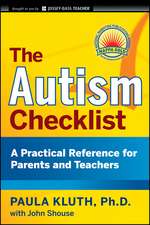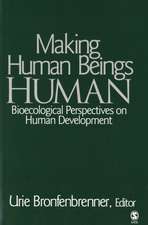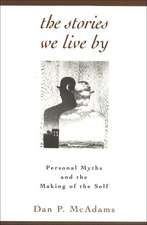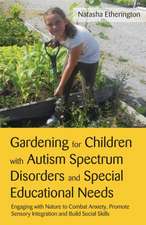Children's Play, Pretense, and Story: Studies in Culture, Context, and Autism Spectrum Disorder
Editat de Susan Douglas, Lesley Stirlingen Limba Engleză Paperback – 15 dec 2015
This collection begins with an approach to understanding the developmental relationship between play and story, which recognizes their similarities while acknowledging their differences. Much of the collection addresses pretend play and story in children with autism spectrum disorder, an understudied but important group for consideration, as these dimensions of their lives and development have often been considered problematic. The volume also includes sections on play and story in classroom settings and play and story across cultures, including non-English-speaking environments such as Israel, Romania, China, and Mexico. It concludes with a discussion of how play differs across sociocultural and economic contexts, making a unifying claim for the importance of play in children’s lives but also calling for an understanding of what play means to very different groups of children.
| Toate formatele și edițiile | Preț | Express |
|---|---|---|
| Paperback (1) | 371.76 lei 3-5 săpt. | +22.85 lei 4-10 zile |
| Taylor & Francis – 15 dec 2015 | 371.76 lei 3-5 săpt. | +22.85 lei 4-10 zile |
| Hardback (1) | 1113.91 lei 6-8 săpt. | |
| Taylor & Francis – 12 dec 2015 | 1113.91 lei 6-8 săpt. |
Preț: 371.76 lei
Nou
Puncte Express: 558
Preț estimativ în valută:
71.15€ • 74.00$ • 58.73£
71.15€ • 74.00$ • 58.73£
Carte disponibilă
Livrare economică 24 martie-07 aprilie
Livrare express 07-13 martie pentru 32.84 lei
Preluare comenzi: 021 569.72.76
Specificații
ISBN-13: 9781848725447
ISBN-10: 1848725442
Pagini: 342
Ilustrații: 7 black & white tables
Dimensiuni: 152 x 229 x 18 mm
Greutate: 0.46 kg
Ediția:1
Editura: Taylor & Francis
Colecția Routledge
Locul publicării:Oxford, United Kingdom
ISBN-10: 1848725442
Pagini: 342
Ilustrații: 7 black & white tables
Dimensiuni: 152 x 229 x 18 mm
Greutate: 0.46 kg
Ediția:1
Editura: Taylor & Francis
Colecția Routledge
Locul publicării:Oxford, United Kingdom
Cuprins
1. Young Children’s Pretend Play and Storytelling as Modes of Narrative Activity: From Complementarity to Cross-Fertilization? Ageliki Nicolopoulou Part 1: Pretence and Storytelling in Autism Spectrum Disorder 2. Pretend Play in Children With Autism Spectrum Disorders: A Review of the Literature Mahwish Chaudry and Cheryl Dissanayake 3. Play, Narrative, and Children With Autism Karen Stagnitti 4. Developing Reciprocity With Technology and Storytelling: The Design of an Authorable Virtual Peer for Children With Autism Spectrum Disorder Andrea Tartaro and Justine Cassell 5. Social Robots as Storytellers: Can A Social Robot Encourage Children With ASD To Ask Questions During Playtime? Ramona Simut, Cristina Costescu, Johan Vanderfaeillie, Daniel David and Bram Vanderborght 6. The Intersection of Pretense and Storytelling In Children With Autism Spectrum Disorder Susan Douglas and Lesley Stirling 7. Dad! You Have to be…: Autism, Narrative And Family Neil Maclean Part 2: Pretence and Storytelling in the Classroom 8. The Wrongheaded Exclusion of Imaginative Storytelling from Kindergarten Writing Instruction Patricia M. Cooper 9. The Development of Subteacher Discourse during Pretend Play in the Wake of Reading A Story Esther Vardi-Rath, Teresa Lewin, Zehava Cohen, Hadassah Aillenberg and Tamar Eylon 10. The Natural World as Content for Interconnection and Divergence of Pretence and Storytelling in Children’s Play Kumara Ward Part 3: Pretence and Storytelling in Cross-Cultural Development 11. Using Narratives and Drawings to Assess Creativity in Preschool Age Children Candice M. Mottweiler 12. A Cultural-Historical Reading of Imagination and Creativity in Young Children’s Shared Narrative Creations across Cultural Contexts Sue March, Liang Li and Gloria Quiñones 13. Returning To Play: The Critical Location of Play in Children’s Sociocultural Lives Artin Göncü and Jennifer A. Vadeboncoeur
Recenzii
'This richly eclectic work draws on various perspectives to examine the dynamic interplay between pretend play and narrative and the complex issues that children on the autism spectrum encounter in these areas. The themes and viewpoints explored not only deepen our theoretical understanding, but also highlight new avenues for research and practice within diverse sociocultural contexts and an ever-changing, techno-oriented world.' – Pamela Wolfberg, Ph.D., Professor, San Francisco State University and founding director, Autism Institute on Peer Socialization and Play, www.autisminstitute.com
'An excellent text grounded in robust research and full of rich and varied perspectives on children’s pretend play and story. I strongly recommend it to all those who are interested to know more about the unique and powerful role of pretense in human development.' – Sue Rogers, Ph.D., Professor, University College London
'An excellent text grounded in robust research and full of rich and varied perspectives on children’s pretend play and story. I strongly recommend it to all those who are interested to know more about the unique and powerful role of pretense in human development.' – Sue Rogers, Ph.D., Professor, University College London
Notă biografică
Susan Douglas is a developmental linguist specializing in language acquisition in children with autism spectrum disorder. Her research interests include syntactic and semantic acquisition, narrative development, and the discourse structure of pretend play.
Lesley Stirling is a linguist and cognitive scientist working on descriptive and typological linguistics, semantics, and discourse analysis, especially of narrative. She has been researching communication in autism for over a decade, focusing on the discourse analysis of children’s stories and play interactions.
Lesley Stirling is a linguist and cognitive scientist working on descriptive and typological linguistics, semantics, and discourse analysis, especially of narrative. She has been researching communication in autism for over a decade, focusing on the discourse analysis of children’s stories and play interactions.
Descriere
This collection explores how storytelling and pretence interconnect, diverge, and influence each other in the course of development—both in neurotypical children and in children with Autism Spectrum Disorder (ASD)





















